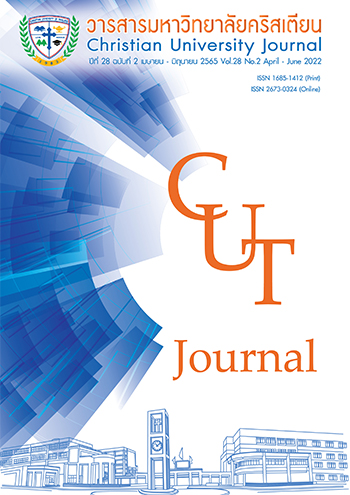ความสัมพันธ์ของลักษณะการบาดเจ็บ โครงสร้างและบริเวณที่บาดเจ็บ กับตำแหน่งการเล่นและปัจจัยที่มีผลต่อการบาดเจ็บของนักกีฬาฟุตบอลอาชีพ ระดับไทยลีก 3 และไทยลีก 4 ในเขตภาคใต้
คำสำคัญ:
ลักษณะการบาดเจ็บ, โครงสร้างและบริเวณที่บาดเจ็บ, ตำแหน่งการเล่น, นักกีฬาฟุตบอลอาชีพบทคัดย่อ
การวิจัยนี้มีวัตถุประสงค์เพื่อศึกษาความสัมพันธ์ของลักษณะการบาดเจ็บ โครงสร้างและบริเวณที่บาดเจ็บกับตำแหน่งการเล่น และปัจจัยที่มีผลต่อการบาดเจ็บในนักกีฬาฟุตบอลอาชีพระดับไทยลีก 3 และ 4 เขตภาคใต้ กลุ่มตัวอย่างเป็นนักกีฬาฟุตบอลอาชีพ จำนวน 103 คน เก็บรวบรวมข้อมูลโดยใช้แบบสัมภาษณ์ข้อมูลการบาดเจ็บในฤดูกาลแข่งขัน 2018 - 2019 วิเคราะห์ข้อมูลโดยใช้สถิติสหสัมพันธ์แบบเพียร์สัน (Pearson correlation coefficient) ผลการศึกษาพบว่า ลักษณะการบาดเจ็บส่วนใหญ่เป็นแผลฟกช้ำและเอ็นยึดข้อฉีกขาด โครงสร้างการบาดเจ็บส่วนใหญ่พบที่ผิวหนัง เอ็นยึดข้อและข้อต่อ บริเวณของร่างกายที่บาดเจ็บส่วนใหญ่พบที่ข้อเท้าและต้นขา ตำแหน่งผู้เล่นที่มีการบาดเจ็บส่วนใหญ่ ได้แก่ กองหลัง กองกลาง กองหน้า และผู้รักษาประตู ตามลำดับ นอกจากนี้ลักษณะการบาดเจ็บ โครงสร้างและบริเวณที่บาดเจ็บไม่มีความสัมพันธ์อย่างมีนัยสำคัญทางสถิติกับตำแหน่งการเล่น แต่พบว่าความถี่ของการบาดเจ็บมีความสัมพันธ์อย่างมีนัยสำคัญทางสถิติกับประวัติการบาดเจ็บในอดีต (r = 0.294, p = 0.003) ระดับใบอนุญาตของหัวหน้าผู้ฝึกสอน (r = 0.206, p = 0.037) และระยะเวลาในการฝึกความแข็งแรงของกล้ามเนื้อ (r = 0.213, p = 0.031) งานวิจัยนี้ชี้ให้เห็นว่าลักษณะการบาดเจ็บ โครงสร้างและบริเวณที่บาดเจ็บไม่มีความสัมพันธ์กับตำแหน่งการเล่น แต่ความถี่ในการบาดเจ็บมีความสัมพันธ์กับประวัติการบาดเจ็บในอดีต ระดับใบอนุญาตของหัวหน้า ผู้ฝึกสอนและระยะเวลาในการฝึกความแข็งแรงของกล้ามเนื้อ
เอกสารอ้างอิง
กนกนันทร์ สุเชาว์อินทร์, กมลชนก ชมจินดา และณัฐพล แสงทอง. (2557). การศึกษาอุบัติการณ์การบาดเจ็บของนักกีฬาฟุตบอลชาย ชุมนุมฟุตบอลมหาวิทยาลัยธรรมศาสตร์ ระหว่างการฝึกซ้อมและการแข่งขัน. ธรรมศาสตร์เวชสาร, 14(3), 340-348.
Arnason, A., Sigurdsson, S.B., Gudmundsson, A., Holme, I., Engebretsen, L., & Bahr, R. (2004). Risk factors for injuries in football. The American Journal of Sports Medicine, 32(1), 5S-16S. doi: 10.1177/0363546503258912.
Astrid, U., & Jiri, D.R. (2015). Football Injuries during the 2014 FIFA World Cup. British Journal of Sports Medicine, 49(9), 599–602. doi: 10.1136/bjsports-2014-094469
Beijsterveldt, A.M.C., Port, I.G.L, Krist, M.R., Schmikli, S.L., Stubbe, J.H., Frederiks, J.E., & Backx, F.J.G. (2012). Effectiveness of an injury prevention programme for adult male amateur soccer players: A cluster-randomized controlled trial. British Journal of Sports Medicine, 46(16), 1114-1118. doi: 10.1136/bjsports-2012-091277
Beijsterveldt, A.M.C., Stubbe, J.H., Schmikli, S.L., Port I.G.L., & Backx, F.J.G. (2015). Differences in injury risk and characteristics between Dutch amateur and professional soccer players. Journal of Science and Medicine in Sport, 18(2), 145-149. doi:10.1016/j.jsams.2014. 02.004
Bojkowski, L. Eider, J., Sliwowski, R., & Wieczorek, A. (2015). Analysis of the longest distances run by the best soccer players at the FIFA world cup in Brazil in 2014. Central European Journal of Sport Sciences and Medicine, 11(11), 145–151. DOI:10.18276/ cej.2015.3-15
Bujnovky, D., Maly, T., Ford, K.R., Sugimoto, D., Kunzmann, E., Hank, M., & Zahalka, F. (2019). Physical fitness characteristics of high-level youth football players: influence of playing position. Sports, 7(2), 1-10. doi:10.3390/sports7020046
Cohen, J. (1988). Statistical power analysis for the behavioral sciences. (second ed.). Retrieved from http://utstat.toronto.edu/~brunner/oldclass/378f16/readings/CohenPower.pdf
Collins, J., Maughan, R.J., Gleeson, M., Blisborough, J., Jeukendrup, A., Morton, J.P., … McCall, A. (2021). UEFA expert group statement on nutrition in elite football. Current evidence to inform practical recommendations and guide future research. British Journal of Sports Medicine, 55(8), 416-442. doi:10.1136/bjsports-2019-101961
Ejnisman, B., Barbosa, G., Andreoli, C.V., Pochini, A.C., Lobo, T., Zogaib, R., Cohen, M., Bizzini, M., & Dvorak, J. (2016). Shoulder injuries in soccer goalkeepers: review and development of a FIFA 11+ shoulder injury prevention program. Open Access Journal of Sports Medicine, 8(7), 75-80. doi:10.2147/OAJSM.S97917.
Eric, G., & Micheli L.J. (2005). Soccer injuries. Medicine and Sport Science, 49, 140-169. doi: 10.1159/000085395
Football Association of Thailand. (2019). Club Licensing Regulations. Retrieved from http://fathai land.org/downloads.
Joo, C.H., & Seo, D. (2016). Analysis of physical fitness and technical skills of youth soccer players according to playing position. Journal of Exercise Rehabilitation, 12(6), 548-552. https://doi.org/10.12965/jer.1632730.365
Judge, L.W., & Burke, J.R. (2010). The effect of recovery time on strength performance following a high-intensity bench press workout in males and females. International Journal of Sports Physiology and Performance, 5(2), 184-196. doi:10.1123/ijspp.5.2.184
Kumar, S.S., Jadhav, K.G, & Pagare, S. (2008). A pilot study examining injuries in relation to field position of competitive football players. Journal of Exercise Science and Physiotherapy, 4, 50-54.
Kuzuhara, K., Shibata, M., & Uchida, R. (2017). Injuries in Japanese junior soccer players during games and practices. Journal of Athletic Training, 52(12), 1147–1152. doi: 10.4085/1062-6050-52.12.23
Morgan, B.E., & Oberlander, M.A. (2001). An examination of injuries in major league soccer. The inaugural season. The American Journal of Sports Medicine, 29(4), 426-430. doi: 10.1177/03635465010290040701
Oh, S.H., & Joo, C.H. (2018). Comparison of technical and physical activities between 8 vs. 8 and 11 vs. 11 games in young Korean soccer players. Journal of Exercise Rehabilitation, 14(2), 253-258. doi: 10.12965/jer.1836034.017
Richardson, S.O., Andersen, M.B., Morris, T. (2008). Overtraining athletes: Personal journeys in sport. The United State of America, Champaign, IL: Human Kinetics.
Sales, M.M., Browne, R.A.V., Asano, R.Y., Olher, R.R.V., Nova, J.F.V., Simões, M.H.G. (2014). Physical fitness and anthropometric characteristics in professional soccer players of the United Arab Emirates. Revista Andaluza de Medicina del Deporte, 7(3), 106-110. https://doi.org/10.1016/S1888-7546(14)70071-1
Spalding J. (2017). Technical and physical match demands of a NCAA Division I soccer goalkeeper. The United States of America: School of Graduate studies, East Tennessee State University.
Steffen, K., Myklebust, G., Andersen, T.E., Holme, I., & Bahr, R. (2008). Self-reported injury history and lower limb function as risk factors for injuries in female youth soccer. The American Journal of Sports Medicine, 36(4), 700-708. doi: 10.1177/0363546507311598
Swainston, S.C., Wilson, M.R., Jone, M.I. (2020). Player experience during the junior to senior transition in professional football: a longitudinal case study. Frontiers in Psychology, 9(11), 1-14. doi: 10.3389/fpsyg.2020.01672.
Wong, P., & Hong, Y. (2005). Soccer injury in the lower extremities. British Journal of Sports Medicine, 39(8), 473–482. doi:10.1136/bjsm.2004.015511
ดาวน์โหลด
เผยแพร่แล้ว
ฉบับ
ประเภทบทความ
สัญญาอนุญาต
ลิขสิทธิ์ (c) 2022 มหาวิทยาลัยคริสเตียน

อนุญาตภายใต้เงื่อนไข Creative Commons Attribution-NonCommercial-NoDerivatives 4.0 International License.



